Why Indoor Hydroponic Gardening for Beginners Is the Easiest Way to Grow Fresh Food at Home
If you’ve ever dreamed of growing your own fresh herbs, leafy greens, or even juicy tomatoes—but thought you didn’t have the space, time, or green thumb—indoor hydroponic gardening for beginners is the solution you’ve been waiting for. Unlike traditional gardening, hydroponics eliminates the need for soil, reduces water usage by up to 90%, and allows plants to grow 20–30% faster by delivering nutrients directly to their roots. Whether you live in a tiny apartment, a bustling city, or a home with limited outdoor space, indoor hydroponic gardening for beginners makes it possible to cultivate thriving plants year-round, with minimal effort and maximum rewards.
In this comprehensive, step-by-step guide, you’ll learn everything you need to know to start your own hydro indoor setup, even if you’ve never grown a plant before. We’ll cover:
- The science behind indoor hydroponic gardening for beginners and why it’s more efficient than soil.
- How to choose the right hydroponic system for your space and budget.
- A detailed, foolproof setup guide for your first hydro indoor setup.
- The 7 easiest plants to grow hydroponically, perfect for hydroponics small space setups.
- Common mistakes to avoid and pro tips for bigger yields.
- Creative ways to integrate your hydroponic garden into your home decor.
By the end of this guide, you’ll have the confidence and knowledge to start your own indoor hydroponic gardening for beginners journey—and enjoy fresh, homegrown food in as little as 30 days!
Chapter 1: The Science Behind Indoor Hydroponic Gardening for Beginners—How It Works and Why It’s Better Than Soil
What Is Indoor Hydroponic Gardening for Beginners?
Indoor hydroponic gardening for beginners is a method of growing plants without soil, using a nutrient-rich water solution to deliver essential minerals directly to the plant roots. This approach eliminates many of the challenges of traditional gardening, such as weeds, pests, and unpredictable weather. Instead, plants grow in a controlled environment where they receive optimal nutrition, water, and light, resulting in faster growth and higher yields.
For those new to gardening, indoor hydroponic gardening for beginners might sound complex, but it’s actually simpler than you think. With the right setup, you can grow fresh produce year-round, regardless of your climate or available space. Plus, hydroponic systems are highly customizable, making them perfect for hydroponics small space setups in apartments, kitchens, or even offices.
As you can see, indoor hydroponic gardening for beginners offers many advantages over traditional soil gardening. However, if you’re not ready to commit to a hydroponic system just yet, you can still enjoy the benefits of indoor gardening. Our guide on how to start an indoor garden for beginners covers everything you need to know about growing plants in soil indoors. But if you’re excited to try a soil-free, faster, and more efficient method, keep reading to learn how to set up your first hydro indoor setup!”
How Does Indoor Hydroponic Gardening for Beginners Work?
In traditional gardening, plant roots spread out in search of water and nutrients, which can slow down growth. In indoor hydroponic gardening for beginners, nutrients are delivered directly to the roots through water, allowing plants to focus their energy on producing leaves, stems, and fruits. This is why hydroponic plants often grow 20–30% faster than those grown in soil.
Key Components of a Hydroponic System:
- Reservoir: Holds the nutrient-rich water solution.
- Growing Medium: Supports the plant roots and holds moisture (e.g., clay pebbles, rockwool, or coco coir).
- Nutrient Solution: A balanced mix of essential minerals like nitrogen, phosphorus, and potassium.
- Light Source: Since most indoor spaces lack natural light, LED or fluorescent grow lights are used to mimic sunlight.
- Air Pump (for some systems): Provides oxygen to the roots, preventing drowning and promoting healthy growth.
📌 Why This Matters for Beginners:
When I first tried indoor hydroponic gardening for beginners, I was amazed at how quickly my plants grew. My lettuce was ready to harvest in just 30 days—half the time it took in soil! The best part? No weeds, no pests, and no messy dirt to clean up.
The Benefits of Indoor Hydroponic Gardening for Beginners
1. Faster Growth and Higher Yields
Plants grown hydroponically can grow 20–30% faster than those in soil. For example:
- Lettuce can be harvested in 30 days (vs. 60+ days in soil).
- Basil produces 3x more leaves in the same time frame.
- Cherry tomatoes can yield up to 10 lbs per plant in a well-maintained hydro indoor setup.
2. No Soil, No Mess
One of the biggest advantages of indoor hydroponic gardening for beginners is the absence of soil, which means:
- No weeds to pull.
- No soil-borne pests (like aphids or fungus gnats).
- No dirt tracking through your home.
3. Water Efficiency
Hydroponic systems use 90% less water than traditional gardening because the water is recirculated and absorbed directly by the roots. This makes indoor hydroponic gardening for beginners an eco-friendly choice, especially in areas with water restrictions.
4. Perfect for Small Spaces
You don’t need a backyard or even a balcony. A hydroponics small space setup can fit on a kitchen counter, bookshelf, or windowsill. Vertical hydroponic systems are especially popular in urban apartments, where space is limited.
5. Year-Round Gardening
With indoor hydroponic gardening for beginners, you’re not limited by seasons. You can grow fresh herbs, leafy greens, and even fruits in the middle of winter, as long as you provide the right light, nutrients, and temperature.
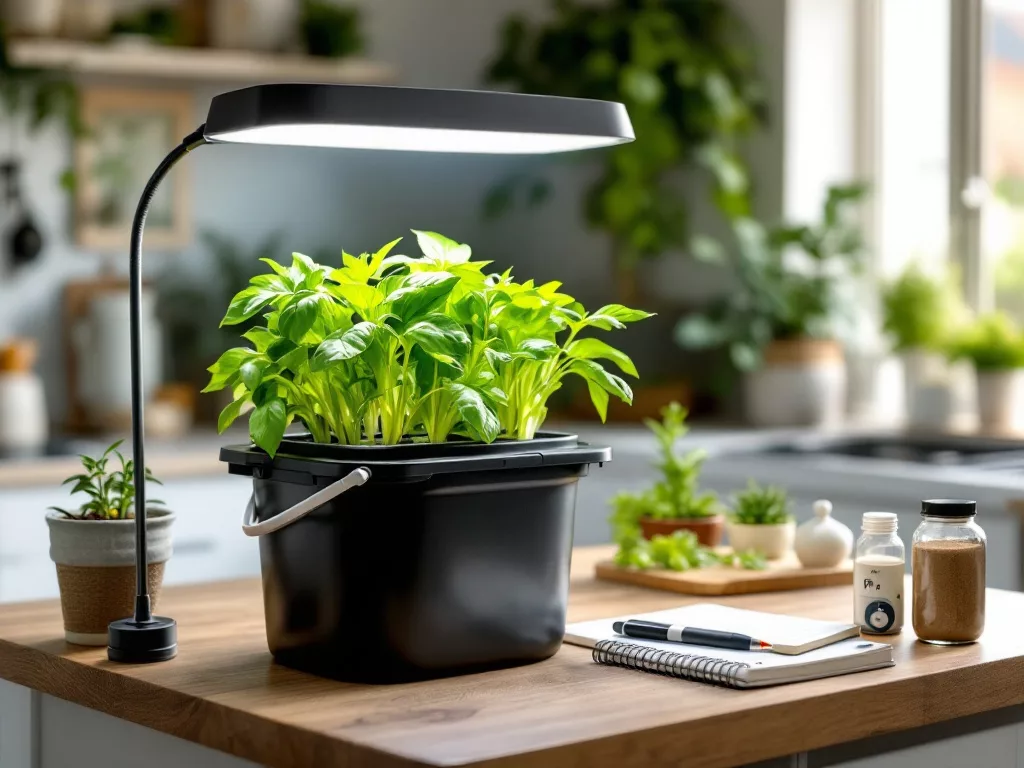
Indoor Hydroponic Gardening vs. Traditional Gardening: A Comparison
| Feature | Indoor Hydroponic Gardening for Beginners | Traditional Gardening |
|---|---|---|
| Growth Speed | 20–30% faster | Slower |
| Space Needed | Minimal (fits in small apartments) | Requires outdoor space |
| Pest Control | Fewer pests (no soil) | Prone to pests and diseases |
| Yield | Higher per square foot | Lower |
| Maintenance | Low (once set up) | High (weeding, watering, etc.) |
| Water Usage | 90% less | High |
📌 Why Choose Indoor Hydroponic Gardening for Beginners?
I live in a tiny apartment with no outdoor space, but indoor hydroponic gardening for beginners allowed me to grow fresh lettuce, basil, and even strawberries right in my kitchen. It’s cleaner, faster, and more rewarding than I ever imagined!
Chapter 2: Choosing the Right Hydroponic System for Your Indoor Hydroponic Gardening for Beginners Setup
Types of Hydroponic Systems for Indoor Hydroponic Gardening for Beginners
There are six main types of hydroponic systems, but for indoor hydroponic gardening for beginners, we recommend starting with one of the three easiest systems:
1. Deep Water Culture (DWC) – Best for Indoor Hydroponic Gardening for Beginners
Best for: Beginners, leafy greens, herbs. How it works: Plants float in a nutrient solution with their roots submerged. An air pump oxygenates the water to prevent drowning. Pros:
- Simple and affordable (can be made with a 5-gallon bucket).
- Fast growth due to constant access to nutrients and oxygen. Cons:
- Not ideal for large plants (like tomatoes or peppers).
- Requires an air pump to oxygenate the water.
📌 Example Setup for Indoor Hydroponic Gardening for Beginners: “A 5-gallon bucket with a net pot lid, air stone, and LED light can grow lettuce or basil in as little as 4 weeks. I started with this hydro indoor setup in my kitchen and was amazed at how quickly my plants grew!”
📌 Recommended Products for Your Hydro Indoor Setup:
- Bucket: 5-Gallon Black Bucket (3 pack) ($25)
- Air Pump: Vivosun Air Pump ($30)
- Net Pots: 2-Inch Net Pots (10-Pack) ($8)
- Grow Light: LED Grow Light Panel (2 pack) ($40)
- ALL IN ONE: Already Done DIY KIT (60$)
2. Kratky Method – The Easiest Hydro Indoor Setup for Beginners
Best for: Beginners, low-maintenance setups, herbs. How it works: Plants grow in a container with a static nutrient solution. As the water level drops, the roots get oxygen from the air gap above the water. Pros:
- No electricity or pumps needed (completely passive).
- Extremely low maintenance (just add water occasionally). Cons:
- Not scalable for large plants.
- Nutrient solution must be balanced perfectly to avoid deficiencies.
📌 Example Setup for Hydroponics Small Space: A mason jar with a net pot lid can grow herbs like mint or cilantro with zero effort. I set one up on my windowsill as part of my indoor hydroponic gardening for beginners journey, and it thrived for months without any adjustments!
📌 Recommended Products:
- Mason Jar: Wide-Mouth Quart Jar ($10)
- Net Pot: 2-Inch Net Pot (10 pack) ($8)
- Nutrients: General Hydroponics Flora Series ($36)
3. Nutrient Film Technique (NFT) – A Step Up for Your Hydro Indoor Setup
Best for: Leafy greens, small fruits (like strawberries). How it works: A thin film of nutrient solution flows over the roots, which are exposed to air. The solution is recirculated using a pump. Pros:
- Efficient use of water and nutrients.
- Good for continuous harvests (like lettuce or spinach). Cons:
- Requires a pump and slight slope for the water to flow.
- Not ideal for large or root-heavy plants.
📌 I built a simple NFT system using PVC pipes and a small water pump for my indoor hydroponic gardening for beginners project. My spinach grew so fast, I had to harvest it every two weeks!
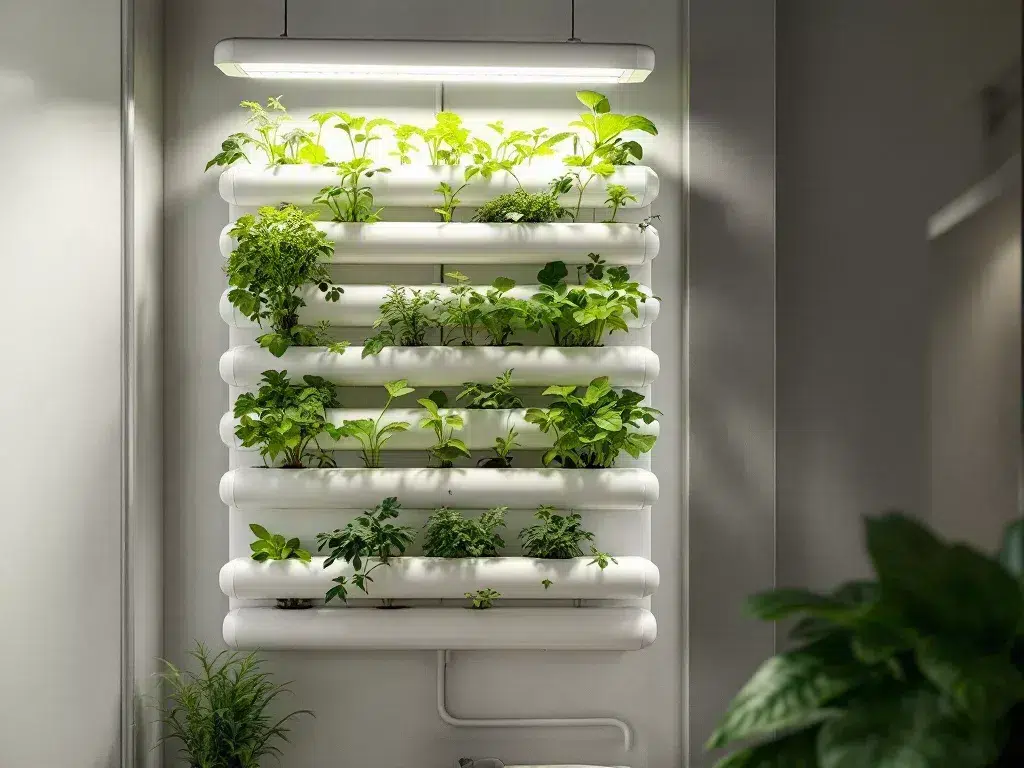
📌 Recommended Products:
- PVC Pipes: 4-Inch PVC Pipes ($20)
- Water Pump: Submersible Water Pump ($25)
- Growing Medium: Rockwool Cubes ($9)
Which Hydroponic System Is Best for Your Indoor Hydroponic Gardening for Beginners Setup?
| System | Difficulty | Cost | Best For |
|---|---|---|---|
| Deep Water Culture | Easy | $50–$100 | Beginners, leafy greens |
| Kratky Method | Easiest | $20–$50 | Herbs, small plants |
| NFT | Intermediate | $100–$200 | Leafy greens, strawberries |
| Ebb & Flow | Advanced | $200+ | Large plants, tomatoes |
📌 Pro Tip for Indoor Hydroponic Gardening for Beginners:
If you’re just starting, go with Deep Water Culture (DWC) or the Kratky Method. They’re affordable, easy to set up, and perfect for hydroponics small space setups. Once you’re comfortable, you can experiment with more advanced systems like NFT or Ebb & Flow for your hydro indoor setup.
Chapter 3: Setting Up Your First Hydro Indoor Setup – A Step-by-Step Guide for Indoor Hydroponic Gardening for Beginners
Step 1: Choose the Right Location for Your Hydro Indoor Setup
The first step in setting up your indoor hydroponic gardening for beginners system is choosing the right location. Here’s what to consider:
- Light: If you’re using natural light, place your system near a south-facing window. For artificial light, LED grow lights are the most efficient (12–16 hours/day).
- Temperature: Keep your growing area between 65–75°F (18–24°C). Avoid drafts or extreme temperature fluctuations.
- Humidity: Aim for 40–60% humidity. If your home is dry, consider a small humidifier.
📌 I set up my first DWC system in my kitchen under a $30 LED grow light for my indoor hydroponic gardening for beginners project. The lettuce grew so fast, I had to harvest it every 2 weeks! The key was keeping the temperature steady and the lights on a timer.
Step 2: Gather Your Supplies for Your Hydro Indoor Setup
Here’s a complete shopping list for a basic DWC system for indoor hydroponic gardening for beginners: ItemPurposeCost
| Item | Purpose | Cost |
|---|---|---|
| 5-gallon bucket | Reservoir for nutrient solution | $10 |
| Air pump + stone | Oxygenates the water | $15 |
| Net pots (2–4″) | Holds plants and growing medium | $5 |
| Hydroponic nutrients | Feeds the plants | $20 |
| Clay pebbles | Supports roots and holds moisture | $10 |
| pH meter | Monitors acidity/alkalinity | $15 |
| pH Up/Down | Adjusts pH levels | $10 |
| LED grow light | Provides artificial sunlight | $40 |
📌 Pro Tip: Buy a black bucket to block light and prevent algae growth. Algae can clog your system and compete with your plants for nutrients in your indoor hydroponic gardening for beginners setup.
Step 3: Assemble Your Hydro Indoor Setup
- Drill holes in the bucket lid to fit your net pots. Use a 2-inch hole saw for standard net pots.
- Fill the bucket with water and add nutrients according to the package instructions.
- Adjust the pH to 5.5–6.5 using a pH meter and pH Up/Down solutions.
- Place your plants in net pots filled with clay pebbles or rockwool.
- Add the air stone to the bucket and connect it to the air pump. This ensures the roots get enough oxygen in your indoor hydroponic gardening for beginners system.
📌 Common Mistake: If your plants wilt or turn yellow in your hydro indoor setup, check the pH level first—it’s the #1 cause of hydroponic failures. Most issues can be fixed by adjusting the pH or nutrient balance.
Step 4: Add Light to Your Hydro Indoor Setup
- LED grow lights are the most efficient and mimic natural sunlight.
- Place lights 6–12 inches above your plants.
- Use a timer to provide 12–16 hours of light per day.
📌 I used a $40 LED panel from Amazon for my indoor hydroponic gardening for beginners project, and my basil grew 3x bushier than my soil-grown plants! The key is to keep the lights close enough but not too close to avoid burning the leaves.
Step 5: Monitor and Maintain Your Indoor Hydroponic Gardening for Beginners Setup
- Check water level daily and top off as needed.
- Replace nutrient solution every 1–2 weeks to prevent nutrient deficiencies.
- Prune dead leaves to avoid rot and pests.
- Watch for signs of stress (yellowing leaves, slow growth) and adjust nutrients or pH as needed.
📌 Pro Tip: Keep a gardening journal to track pH levels, nutrient changes, and plant growth in your indoor hydroponic gardening for beginners journey. This will help you troubleshoot issues and improve your hydro indoor setup over time.
Chapter 4: The 7 Easiest Plants to Grow in Your Indoor Hydroponic Gardening for Beginners Setup
1. Butterhead Lettuce – Perfect for Hydroponics Small Space
- Time to Harvest: 30–45 days.
- Light Needs: 10–12 hours.
- Pro Tip: Keep water temperature below 75°F to prevent bolting.
- Why It’s Great for Beginners: Fast-growing, low-maintenance, and perfect for hydroponics small space setups.
2. Basil – A Must-Have for Your Hydro Indoor Setup
- Time to Harvest: 28–40 days.
- Light Needs: 12–14 hours.
- Pro Tip: Prune regularly to encourage bushier growth.
- Why It’s Great for Beginners: Thrives in hydroponics and can be harvested multiple times.
3. Cherry Tomatoes – A Rewarding Challenge for Indoor Hydroponic Gardening for Beginners
- Time to Harvest: 60–80 days.
- Light Needs: 14–16 hours.
- Pro Tip: Use a trellis for support as the plants grow tall.
- Why It’s Great for Beginners: Rewarding to grow, but requires a bit more space and light in your hydro indoor setup.
4. Spinach – Cold-Hardy and Fast-Growing
- Time to Harvest: 30–40 days.
- Light Needs: 10–12 hours.
- Pro Tip: Harvest outer leaves first for continuous growth.
- Why It’s Great for Beginners: Cold-hardy and fast-growing, ideal for indoor hydroponic gardening for beginners.
5. Mint – Nearly Foolproof
- Time to Harvest: 30–60 days.
- Light Needs: 12–14 hours.
- Pro Tip: Mint grows aggressively—keep it in its own container to avoid overcrowding.
- Why It’s Great for Beginners: Nearly foolproof and great for teas and cooking in your hydro indoor setup.
6. Cilantro – Fast and Flavorful
- Time to Harvest: 30–50 days.
- Light Needs: 12 hours.
- Pro Tip: Harvest before it flowers for the best flavor.
- Why It’s Great for Beginners: Fast-growing and versatile in the kitchen for indoor hydroponic gardening for beginners.
7. Strawberries – Sweet and Rewarding
- Time to Harvest: 60–90 days.
- Light Needs: 14–16 hours.
- Pro Tip: Use a NFT or DWC system for best results.
- Why It’s Great for Beginners: Delicious and rewarding, but requires patience in your hydroponics small space setup.
📌 Visual Guide:
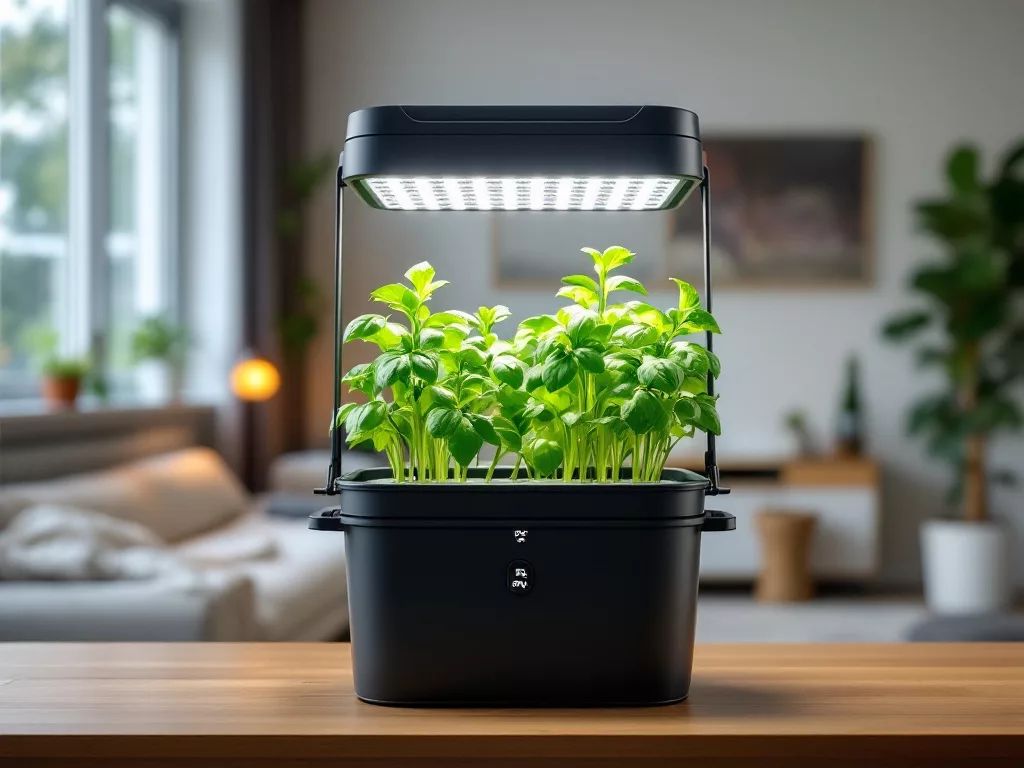
Chapter 5: 5 Common Mistakes in Indoor Hydroponic Gardening for Beginners (And How to Fix Them)
1. Ignoring pH Levels in Your Hydro Indoor Setup
Problem: If the pH is too high or too low, plants can’t absorb nutrients, leading to deficiencies and poor growth.
Solution: Test pH daily with a pH meter and adjust to 5.5–6.5 using pH Up or Down solutions.
2. Overcrowding Plants in Your Hydroponics Small Space
Problem: Too many plants in one system lead to root competition, stunted growth, and disease.
Solution: Follow spacing guidelines (e.g., 1 plant per net pot in DWC).
3. Skipping Nutrient Changes in Your Indoor Hydroponic Gardening for Beginners Setup
Problem: Nutrients deplete over time, leading to deficiencies and slow growth.
Solution: Replace the nutrient solution every 1–2 weeks.
4. Poor Lighting in Your Hydro Indoor Setup
Problem: Weak or inconsistent light results in leggy, weak plants.
Solution: Use full-spectrum LED grow lights for 12–16 hours/day.
5. Not Cleaning Your Hydro Indoor Setup
Problem: Algae and bacteria can clog pumps and harm plants.
Solution: Clean the reservoir and replace water every 2 weeks.
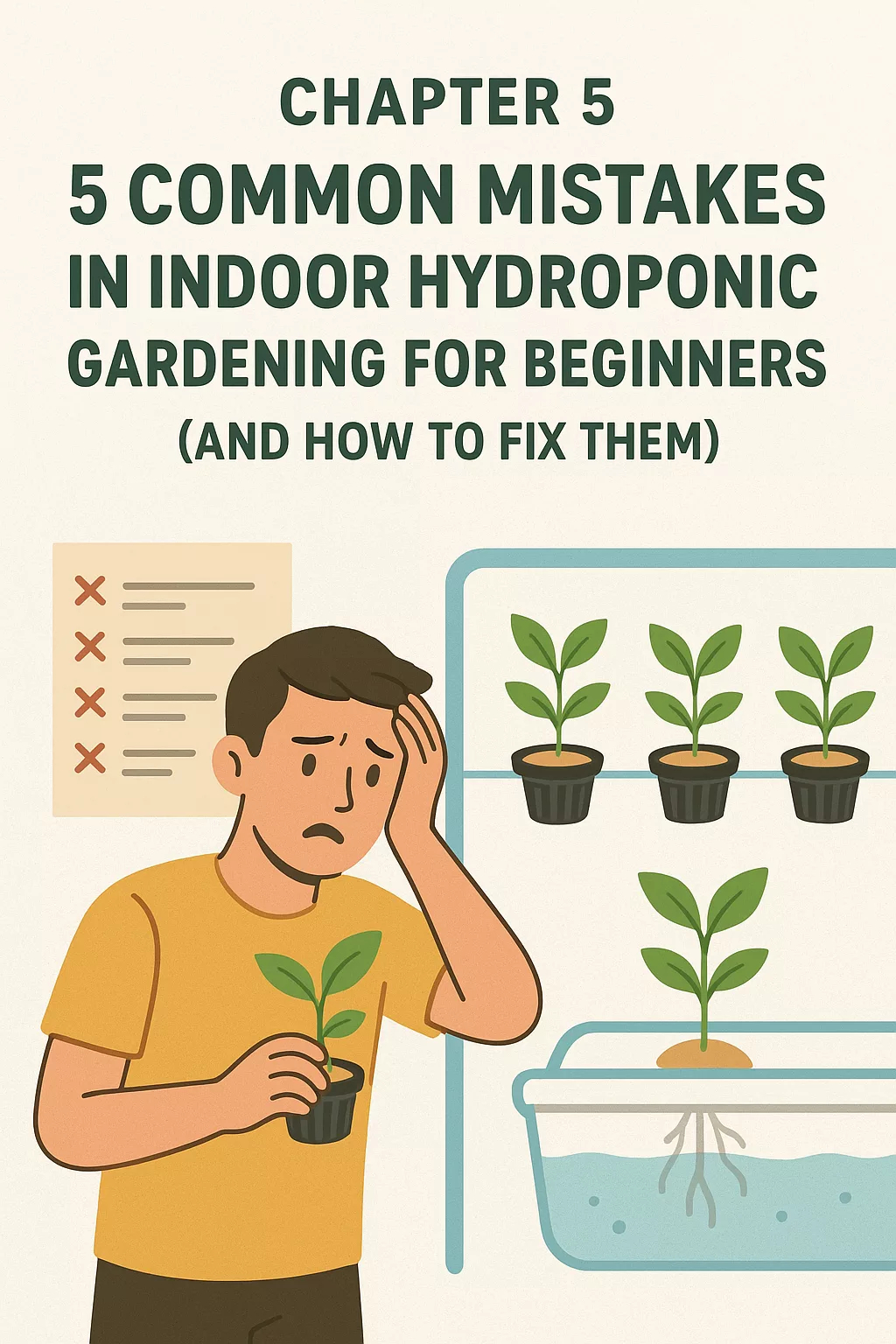
📌According to a study by the University of Arizona, 80% of hydroponic failures are due to pH imbalances or nutrient deficiencies. Monitoring these two factors can dramatically improve your success rate in indoor hydroponic gardening for beginners.
Chapter 6: Advanced Tips for Bigger Yields in Your Indoor Hydroponic Gardening for Beginners Setup
1. Prune Regularly
Removing dead or yellowing leaves redirects energy to healthy growth and prevents disease in your hydro indoor setup.
2. Pollinate by Hand
For fruiting plants like tomatoes, gently shake the plant or use a small brush to transfer pollen.
3. Boost CO2 Levels
Adding a small fan improves air circulation and strengthens plant stems in your indoor hydroponic gardening for beginners system.
4. Use Beneficial Bacteria
Products like HydroGuard prevent root rot and promote healthy root growth in your hydroponics small space setup.
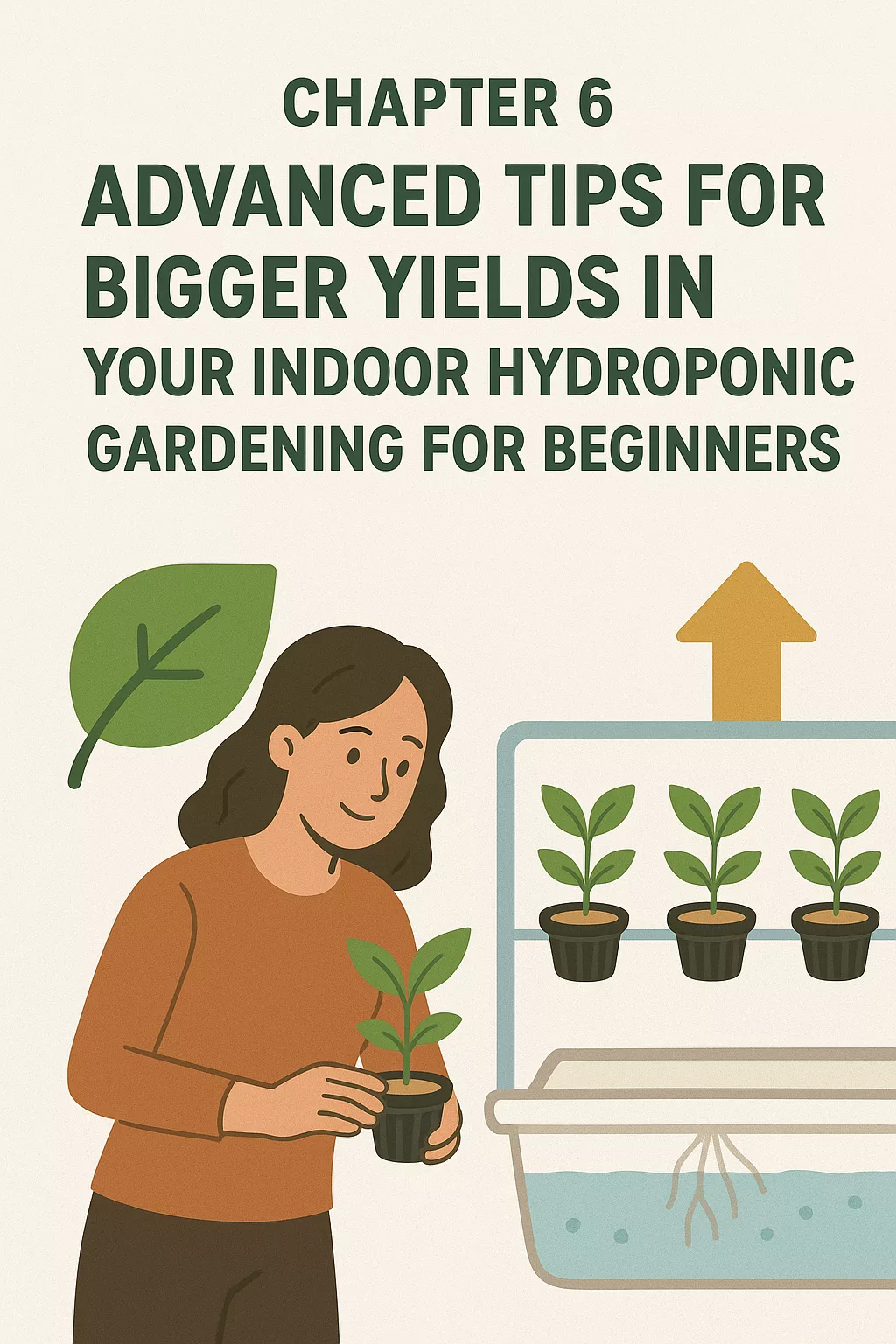
📌 Pro Tip: I added a $20 oscillating fan to my hydro indoor setup, and my basil grew 50% faster! The gentle breeze mimics outdoor conditions and strengthens the plants in indoor hydroponic gardening for beginners.
Chapter 7: Creative Ways to Style Your Hydro Indoor Setup for Hydroponics Small Space
1. Vertical Gardens for Hydroponics Small Space
Use PVC pipes or stackable trays to maximize space in small apartments for your indoor hydroponic gardening for beginners project.
2. Aesthetic Containers for Your Hydro Indoor Setup
- Mason jars for herbs.
- Sleek black buckets for a modern look.
3. LED Light Art for Indoor Hydroponic Gardening for Beginners
Colorful grow lights can double as ambient lighting in your home, adding a stylish touch to your hydroponics small space setup.
📌I mounted a vertical NFT system on my kitchen wall for my indoor hydroponic gardening for beginners project. It’s not just functional—it’s a conversation piece that adds life to my space!
Chapter 8: Case Study—From Zero to Harvest in 6 Weeks with Indoor Hydroponic Gardening for Beginners
Sarah’s Story: “I live in a 300 sq. ft. apartment in New York with no outdoor space. I started with a $75 DWC setup for my indoor hydroponic gardening for beginners journey and grew lettuce and basil. In 6 weeks, I harvested 2 lbs of lettuce and 1 lb of basil—with zero prior experience! The key was monitoring pH and nutrients and keeping the lights on a timer in my hydro indoor setup.“
📌 Key Takeaways:
- Start small (DWC or Kratky).
- Anyone can do it—no green thumb required for indoor hydroponic gardening for beginners!
FAQs About Indoor Hydroponic Gardening for Beginners
Is indoor hydroponic gardening for beginners expensive to start?
A basic hydro indoor setup can cost as little as $50–$100 (DWC or Kratky). While there’s an upfront cost, you’ll save money in the long run by growing your own food in your indoor hydroponic gardening for beginners system.
Can I grow hydroponics without electricity?
Yes! The Kratky Method is completely passive and requires no pumps or electricity. It’s perfect for off-grid or low-tech setups in indoor hydroponic gardening for beginners.
What’s the easiest plant for indoor hydroponic gardening for beginners?
Lettuce and basil are foolproof and grow quickly. They’re also forgiving if you make minor mistakes with nutrients or light in your hydro indoor setup.
How often should I check my indoor hydroponic gardening for beginners system?
Check water levels daily and test pH and nutrients weekly. Most issues can be caught early with regular monitoring in your hydroponics small space setup.
Conclusion: Start Your Indoor Hydroponic Gardening for Beginners Journey Today!
You now have everything you need to start your own indoor hydroponic gardening for beginners journey. Hydroponics is more than just a gardening method—it’s a revolutionary way to grow food faster, cleaner, and with less effort than traditional gardening. Whether you’re growing herbs for your kitchen or tomatoes for your salads, indoor hydroponic gardening for beginners makes it possible—anywhere, anytime.
Ready to get started?
- Pick a system (DWC or Kratky for beginners).
- Gather your supplies (use the shopping list above).
- Plant your seeds and watch them thrive in your hydro indoor setup!
Your future self—and your taste buds—will thank you.
🌱 Happy growing! 😊
💡More information how to start with hydroponic system
